Whisper of Spring |
|||||||||||||||||||
 |
 |
||||||||||||||||||
Knitted sweater in DROPS Alpaca and DROPS Kid-Silk. The piece is worked top down with European/diagonal shoulders, cables and split in sides. Sizes S - XXXL.
DROPS 243-6 |
|||||||||||||||||||
|
------------------------------------------------------- EXPLANATIONS FOR THE PATTERN: ------------------------------------------------------- GARTER STITCH (worked back and forth): Knit all rows. 1 ridge = knit 2 rows. INCREASE TIP FROM RIGHT SIDE: Increase to left AFTER A.1 / 3 stitches: Use left needle to pick up thread between 2 stitches from row below, pick up thread from front and knit stitch in back loop. Increase to right BEFORE A.2 / 3 stitches: Use left needle to pick up thread between 2 stitches from row below, pick up thread from behind and knit stitch in front loop. INCREASE TIP FROM WRONG SIDE: Increase to left AFTER A.2: Use left needle to pick up thread between 2 stitches from row below, pick up thread from behind and purl stitch in front loop. Increase to right BEFORE A.1: Use left needle to pick up thread between 2 stitches from row below, pick up thread from front and purl stitch in back loop. DECREASE TIP (for sleeves): Decrease 1 stitch on each side of the marker-thread as follows: Work until there are 3 stitches left before the marker-thread, knit 2 together, knit 2 (marker-thread sits between these 2 stitches), slip 1 stitch knit-wise, knit 1 and pass the slipped stitch over the knitted stitch. ------------------------------------------------------- START THE PIECE HERE: ------------------------------------------------------- SWEATER – SHORT OVERVIEW OF THE PIECE: The top of the back piece is worked back and forth on circular needle until the armholes are finished. Stitches are knitted up along each shoulder for the front piece. Then increased for the neck. Then the front piece is worked back and forth on circular needle until the armholes are finished. The pieces are joined and the body worked in the round. Stitches are knitted up around the armholes and the sleeves worked first back and forth for the sleeve cap, then in the round with short circular needle/double pointed needles. The neck is worked to finish. BACK PIECE: Cast on 34-34-38-40-42-44 stitches with circular needle size 5 MM = US 8 and 1 strand DROPS Alpaca and 1 strand DROPS Kid-Silk (2 strands). Purl 1 row from the wrong side. Now work as follows from the right side: Work A.1, 12-12-16-18-20-22 stitches in stockinette stitch, A.2. AT THE SAME TIME on the first row increase AFTER A.1 at the beginning of the row and BEFORE A.2 at the end of the row – read INCREASE TIP FROM RIGHT SIDE. On the next row (wrong side) increase after A.2 and before A.1 – read INCREASE TIP FROM WRONG SIDE. Continue increasing from both the right and wrong side a total of 26-28-28-30-32-36 times = 86-90-94-100-106-116 stitches. Continue the pattern for 6 rows, without increasing. Insert a marker in each side; the piece is now measured from here! REMEMBER THE KNITTING GAUGE! Continue the pattern until the piece measures 14-15-16-17-17-18 cm = 5½"-6"-6¼"-6¾"-6¾"-7" from the marker and down the armholes. Cut the strand. Place the stitches on a stitch holder. FRONT PIECE: Start on the left shoulder (when the garment is worn). Knit up 26-28-28-30-32-36 stitches inside 1 stitch along the left shoulder on the back piece; start by the neck and knit up stitches as far as the marker in the side of the back piece. Work stockinette stitch back and forth for 4 cm = 1½". Increase for the neck at the beginning of each row from the right side, after 3 stitches - remember INCREASE TIP FROM RIGHT SIDE. Increase 1 stitch 4 times = 30-32-32-34-36-40 stitches. Purl 1 row from the wrong side. Cut the strand. Place the stitches on a stitch holder and work the right front shoulder as follows. Knit up 26-28-28-30-32-36 stitches inside 1 stitch along the right shoulder on the back piece. Start by the marker and knit up stitches as far as the neck. Work stockinette stitch back and forth for 4 cm = 1½". Increase for the neck at the end of each row from the right side, before 3 stitches - remember INCREASE TIP FROM RIGHT SIDE. Increase 1 stitch 4 times = 30-32-32-34-36-40 stitches. Purl back from the wrong side. Work the next row as follows from the right side: Work the 30-32-32-34-36-40 stitches from the right shoulder, cast on 22-22-26-28-30-32 stitches for the neck and work the 30-32-32-34-36-40 stitches from the left front shoulder = 82-86-90-96-102-112 stitches. NOTE! There are 4 more stitches on the back piece than on the front piece because the cables tighten the piece slightly. Work stockinette stitch back and forth until the piece measures 24-25-26-27-29-30 cm = 9½"-9¾"-10¼"-10⅝"-11⅜"-11¾" down the armhole. Now join the front and back pieces for the body. BODY: Work the 82-86-90-96-102-112 stitches from the front piece, cast on 4-6-8-12-16-16 stitches (= side), work stockinette stitch with A.1/A.2 over the 86-90-94-100-106-116 stitches from the back piece, cast on 4-6-8-12-16-16 stitches = 176-188-200-220-240-260 stitches. Work stockinette stitch, A.1 and A.2 in the round until the piece measures 46-48-50-52-54-46 cm = 18"-19"-19¾"-20½"-21¼"-18", from the top of the shoulder on the front piece. Now divide for the split in each side. Work the 86-92-98-108-118-128 stitches from the front piece and place them on a stitch holder and work the back piece. BACK PIECE: = 90-96-102-112-122-132 stitches. Change to circular needle size 3.5 MM = US 4. Knit 1 row from the right side and increase 34-34-38-44-46-48 stitches evenly spaced between the outermost 13-14-15-17-19-19 stitches on each side = 124-130-140-156-168-180 stitches. Work as follows from the wrong side: A.3 (see diagram for your size and start on 2nd row in diagram), * purl 2, knit 2 *, work from *-* until there are 15-16-17-19-21-21 stitches left, purl 2 and A.4 (see diagram for your size, and start on 2nd row in diagram). Work this rib for 10 cm = 4". Bind off. The sweater measures approx. 56-58-60-62-64-66 cm = 22"-22¾"-23⅝"-24⅜"-25¼"-26" from the top of the shoulder. FRONT PIECE: = 86-92-98-108-118-128 stitches. Knit 1 row from the right side and increase 36-38-40-46-48-50 stitches evenly spaced = 122-130-138-154-166-178 stitches. Work the next row from the wrong side as follows: 2 edge stitches in GARTER STITCH – read description above, * purl 2, knit 2 *, work from *-* until there are 4 stitches left, purl 2 and 2 edge stitches in garter stitch. Work this rib for 10 cm = 4". Bind off. The sweater measures approx. 56-58-60-62-64-66 cm = 22"-22¾"-23⅝"-24⅜"-25¼"-26" from the top of the shoulder. LEFT SLEEVE: Using circular needle size 5 MM = US 8 and 1 strand DROPS Alpaca and 1 strand DROPS Kid-Silk, knit up from the right side 37-39-41-43-46-48 stitches from the bottom of the armhole and up the front piece to the shoulder, then 27-29-31-31-32-34 stitches from the shoulder down the back piece = 64-68-72-74-78-82 stitches. Insert a marker in the middle of the row – the sleeve is measured from this marker. Work stockinette stitch back and forth for 1-2-2-4-5-5 cm = ⅜"-¾"-¾"-1½"-2"-2". Now join the sleeve on short circular needle/double pointed needles size 5 MM = US 8 and work in the round. Insert 1 marker-thread at the beginning of the round (mid-under sleeve). Allow it to follow your work onwards. Start at the marker-thread and continue with stockinette stitch. When the sleeve measures 4-4-4-5-6-6 cm = 1½"-1½"-1½"-2"-2⅜"-2⅜" from the marker, decrease 2 stitches mid-under the sleeve – read DECREASE TIP. Decrease like this every 6-4-3-3-2½-2 cm = 2⅜"-1½"-1⅛"-1⅛"-1"-¾" a total of 6-8-9-9-10-11 times = 52-52-54-56-58-60 stitches. Continue working until the sleeve measures 38-38-38-37-36-34 cm = 15"-15"-15"-14½"-14¼"-13⅜". There is 10 cm = 4" left; try the sweater on and work to desired length before the rib. Knit 1 round and increase 16-16-18-16-18-20 stitches evenly spaced = 68-68-72-72-76-80 stitches. Change to double pointed needles size 3.5 MM = US 4. Work rib (knit 2, purl 2) for 10 cm = 4". Bind off. The sleeve measures approx. 48-48-48-47-46-44 cm = 19"-19"-19"-18½"-18"-17¼" from the marker. RIGHT SLEEVE: Knit up and work in the same way as the left sleeve but, when knitting up stitches, knit up 27-29-31-31-32-34 stitches from the bottom of the armhole and up the back piece and 37-39-41-43-46-48 stitches from the shoulder and down the front piece. Sew the bottom of the armholes – see sketch. NECK: Start on one shoulder and knit up from the right side (inside 1 stitch) 88 to 120 stitches with short circular needle size 3.5 MM = US 4 and 1 strand of each quality. Stitch number must be divisible by 4. Work rib in the round (knit 2, purl 2) for 10 cm = 4". Bind off. Fold the neck double to the inside and fasten with a stitch in each side. |
|||||||||||||||||||
Diagram explanations |
|||||||||||||||||||
|
|||||||||||||||||||

|
|||||||||||||||||||

|
|||||||||||||||||||
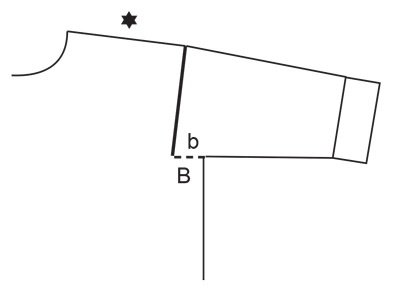
|
|||||||||||||||||||

|
|||||||||||||||||||

|
|||||||||||||||||||
|
Have you made this or any other of our designs? Tag your pictures in social media with #dropsdesign so we can see them! Do you need help with this pattern?You'll find tutorial videos, a Comments/Questions area and more by visiting the pattern on garnstudio.com. © 1982-2024 DROPS Design A/S. We reserve all rights. This document, including all its sub-sections, has copyrights. Read more about what you can do with our patterns at the bottom of each pattern on our site. |
|||||||||||||||||||








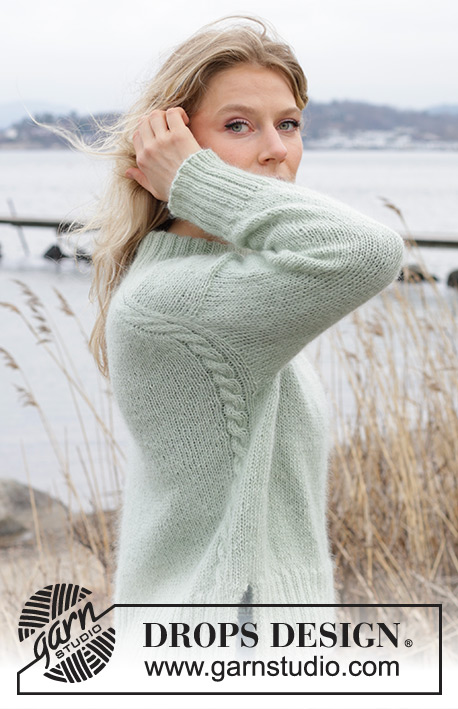


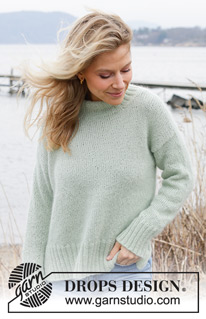
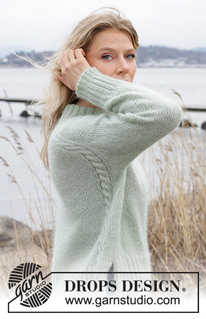













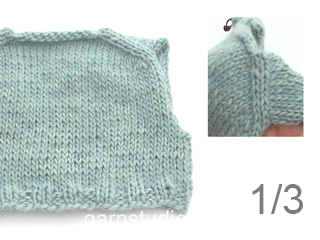
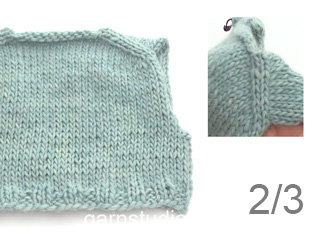
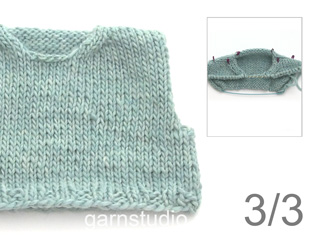


























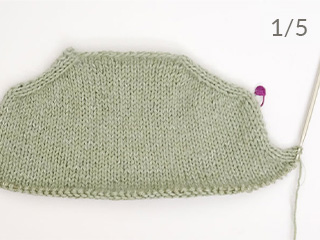
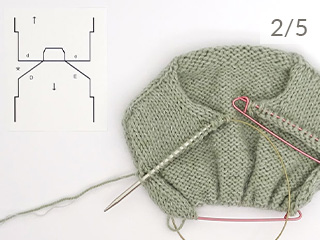
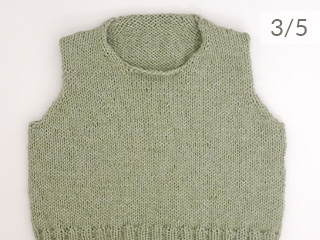

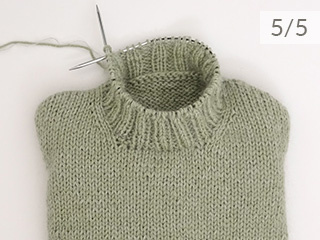























Comments / Questions (22)
Hi there, I'm trying to figure out how to knit back and forth on circular needles when I pick up the stitches on the sleeve? It seems impossible as it's just too tight. I must be missing something here,. Can you help please? Many thanks, Val
05.02.2024 - 22:01DROPS Design answered:
See previous answer below, tell us if it was clear for you.
06.02.2024 - 08:44Hi there, I need to ask about picking up stitches for the sleeves in this pattern on circular needles size 5mm and then knit stocking stitch back and forth for 2cms? I just can't figure out how to do that. It's so tight, I can't go back and forth.. I can just about knit in the round using the magic loop method. Is it really necessary to go back and forth? Can I just knit in the round? I'd appreciate any help you csn give. Thanks, Val
05.02.2024 - 21:58DROPS Design answered:
Dear Mrs O'Donovan, in this pattern you pick up the stitches just along the armhole, not in the new stitches cast on when joining front and back piece together and work back and forth for 2 cm before joining in the round. These 2 cm will be then sewn to the stitches cast on mid under sleeve. Happy knitting!
06.02.2024 - 08:43Nach den 6 Reihen müssen Markierer gesetzt werden. Aber wohin. Direkt nach und vor A1 und A2. .
24.12.2023 - 11:27DROPS Design answered:
Liebe Frau Messin, diese Markierer sollen beidseitig eingesetzt werden, dh in die 1. und in die letzte Masche, von hier wird dann die Arbeit für die Armausschnitt gemessen. Viel Spaß beim stricken!
02.01.2024 - 08:14Buongiorno sto realizzando.il modello.nella taglia xl sul dietro dipo gli aumenti .il segnapunti.lo devo.mettrre prima o dopo i 6 ferri.senza aumenti ? Io l ho.messo dopo ma quando raccolgo le 30 .maglie per i davanti non raggoungo il segnapunti .
18.11.2023 - 10:41DROPS Design answered:
Buonasera Luisa, il segnapunti va dopo i 6 ferri. Buon lavoro!
19.11.2023 - 19:10Rückenteil in Größe M 28 Reihen gestrickt, 90 Maschen auf der Nadel, + 6 Reihen gestrickt = 34 Reihen, Markierer angebracht. Für das Vorderteil soll man nun vom Nacken bis zum Markierer 28 Maschen auffassen, aber 34 sind es! Muß ich Maschen auslassen oder sitzt der Markierer falsch? Vielen Dank
12.11.2023 - 09:23DROPS Design answered:
Liebe Barbara, Markierer sitzt richtig, über diese 34 Reihen wird man nur 28 Maschen regelmäßig verteilt auffassen. Viel Spaß beim stricken!
13.11.2023 - 08:02Sorry.. oder von rechts nach links*
03.11.2023 - 06:47DROPS Design answered:
Nur die Hinreihen werden rechts nach links gelesen. Viel Spaß beim stricken!
03.11.2023 - 06:53Muss ich die 1. Zeile von A3 und A4 von links nach rechts oder von links nach rechts lesen?
03.11.2023 - 06:46DROPS Design answered:
Liebe Meike, die Rückreihen werden links nach rechts gelesen. Viel Spaß beim stricken!
03.11.2023 - 06:53Hallo, ich bin am Rückenteil und soll 34 Maschen gleichmässig verteilt zunehmen und dies zwischen den 13 Maschen am Anfang und Ende der Reihe. Das ergeben 24 Maschen...werden die restlichen 10 Maschen in der Mitte verteilt zugenommen, oder wie verstehe ich das? mfG Rendy
24.10.2023 - 10:42DROPS Design answered:
Liebe Rendy, in S haben Sie 90 Maschen und die Zunahmen stricken Sie zwischen den 13 beidseitigen Maschen, dh: 13 M rechts stricken, 64 M rechts stricken und gleichzeitig 34 M zunehmen, 13 M rechts stricken. Viel Spaß beim stricken!
24.10.2023 - 17:02Hallo, ist es richtig, dass am Ende der Beschreibung von "Vorderteil", die Länge der Arbeit 24cm betragen soll, gemessen außen am Armausschnitt, obschon der Armausschnitt bei S nur 19 cm beträgt? Es sind jetzt schon 2 Fehler in der Anleitung gewesen und ich mußte alles aufziehen... Danke für Kontrolle/ Bestätigung.... LG
18.10.2023 - 23:25DROPS Design answered:
Liebe Rendy, Armausschnitt ist beim europäischen Schulter so richtig, bei S ist es 14 cm lang beim Rückenteil und 24 cm beim Vorderteil, so haben Sie 19 cm Armausschnitt (14+24)/2. Schauen Sie mal die Videos über die europäische Schulter unten, nach der Anleitung und die Diagramme. Viel Spaß beim stricken!
19.10.2023 - 08:16Anja hat mit ihrem Kommentar vom 11.9. recht, es muss in jeder Reihe jeweils 1 Masche nach A1 und vor A2 zugenommen werden und nicht wie in dem Zunahmetipp in Hin-,und Rückreihen beschrieben 3 Maschen!
09.10.2023 - 11:19DROPS Design answered:
Liebe Meike, die 3 Maschen beziehen sich nicht auf die zugenommenen Maschen, sondern darauf, dass am Vorderteil nach bzw. vor 3 Maschen zugenommen wird. A.1 und A.2 gelten ja nur für das Rückenteil. Der Zunahmetipp wurde nun aber etwas umformuliert, sodass er nun hoffentlich eindeutiger ist. Gutes Gelingen!
10.10.2023 - 20:45